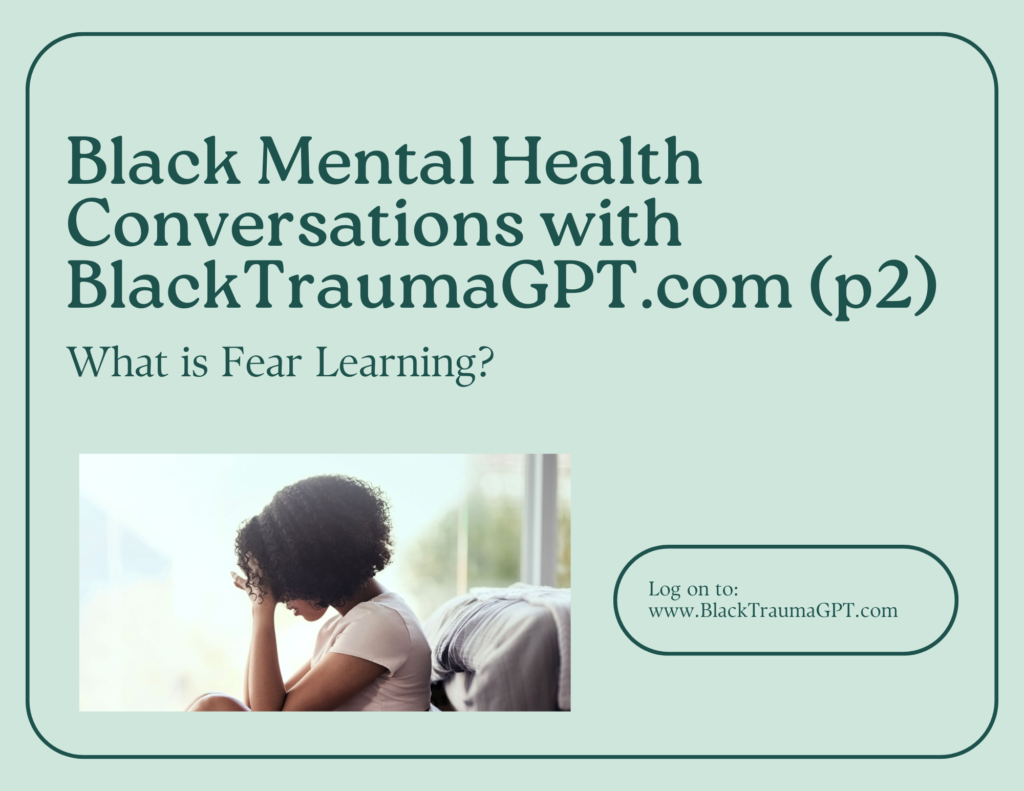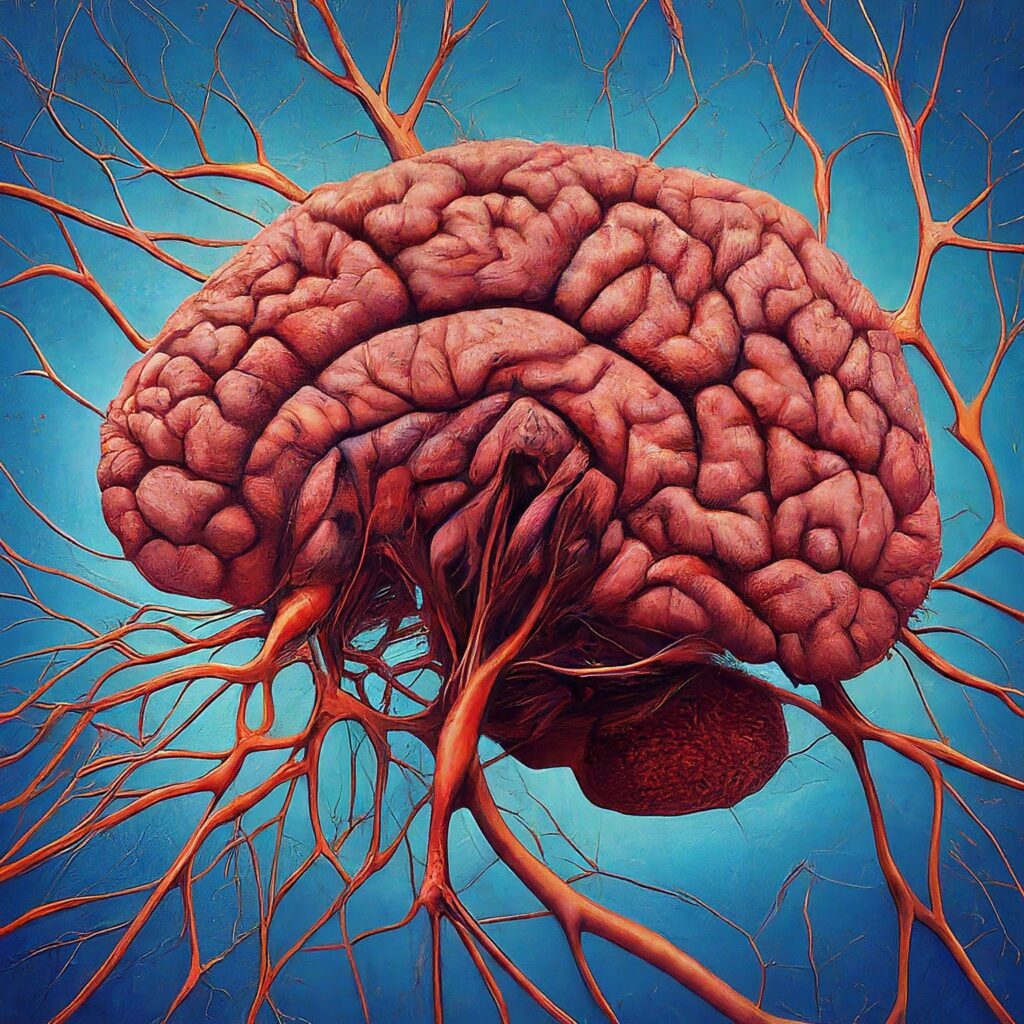
Curated by: Rev. Dr. Philippe SHOCK Matthews
(Black Trauma and Mental Health Specialist | Prompt Eng | GPT Dev | Research Scientist | Africana Phenomenologist)

The Quest-Ion:
What is Fear Learning?
BlackTraumaGPT Answer:
Fear learning is a critical adaptive mechanism that allows organisms, including humans, to recognize and respond to threats, ensuring survival. The process primarily involves the amygdala, a key structure within the limbic system, and can be understood through a few core concepts: classical conditioning, extinction, and sensitization.
Classical Conditioning of Fear
Fear learning is often studied through a process called classical conditioning, famously demonstrated by Pavlov’s experiments with dogs. In the context of fear:
1. Neutral Stimulus: Initially, a stimulus is neutral and does not elicit a fear response (e.g., a tone).
2. Unconditioned Stimulus (US): Something that naturally and automatically triggers a fear response (e.g., an electric shock).
3. Conditioned Stimulus (CS): When the neutral stimulus (tone) is repeatedly paired with the unconditioned stimulus (shock), the neutral stimulus becomes a conditioned stimulus, now capable of triggering the fear response on its own.
This learning process involves the amygdala, which helps encode the association between the conditioned and unconditioned stimuli, storing it as a memory that the conditioned stimulus predicts danger.
Extinction
Extinction is the process through which a conditioned response (CR) decreases or disappears over time as the conditioned stimulus is presented without the unconditioned stimulus. For example, if the tone is repeatedly presented without the shock, the fear response to the tone gradually diminishes. However, extinction does not involve erasing the original fear memory but rather forming a new memory that inhibits the fear response. The amygdala and structures like the hippocampus and prefrontal cortex play crucial roles in this process.
Sensitization
Sensitization refers to an increased reaction to a wide range of stimuli following exposure to a highly stressful or traumatic event. For example, after a traumatic event, an individual might react more intensely to the event-related stimuli and other, non-threatening cues. This heightened state of reactivity is often associated with conditions like PTSD, where the amygdala becomes hyper-responsive to fear-related stimuli.
Fear Learning and Racial Trauma
Understanding fear learning is particularly relevant in the context of racial trauma. Repeated exposure to racial discrimination or violence can condition individuals to anticipate, perceive, and react to racial threats more intensely. The amygdala’s role in fear learning helps explain why individuals from marginalized communities may experience heightened vigilance and anxiety in situations that remind them, even subtly, of past traumas.
Therapeutic approaches, such as trauma-focused cognitive behavioral therapy (CBT) and exposure therapy, often target these learned fear responses. They aim to help individuals re-evaluate and modify their perceptions of fear and safety. In communities impacted by racial trauma, integrating culturally informed practices and community healing strategies can further support the dismantling of conditioned fear responses, fostering resilience and psychological well-being.

Conditioned Stimulus (CS)
– Definition: A Conditioned Stimulus (CS) is a previously neutral stimulus that triggers a conditioned response after being paired with an unconditioned stimulus (UCS). In classical conditioning, the CScrucial in creating a learned association between the CS and the UCS.
– Example: For instance, in Pavlov’s famous experiment with dogs, the sound of a bell (CS) was repeatedly paired with the presentation of food (UCS). Eventually, the dogs started salivating in response to the bell alone, even when food was not presented. Here, the bell became the conditioned stimulus eliciting the salivation response.
– Role in Conditioning: The CS serves as a signal or predictor that informs the organism about the impending occurrence of the unconditioned stimulus. Through repeated pairings, the CS acquires the ability to evoke a response similar to that produced by the UCS.
– Association Formation: The process of classical conditioning involves the formation of an association between the CS and the UCS. The CS gains its significance by being consistently paired with the UCS, leading to the development of a conditioned response.
– Generalization and Discrimination: Once conditioning has occurred, the organism may exhibit generalization, responding to stimuli similar to the CS. Discrimination, on the other hand, involves the ability to differentiate between the CS and other similar stimuli.
– Extinction and Spontaneous Recovery: If the CS is repeatedly presented without the UCS, the conditioned response may weaken and eventually disappear, a process known as extinction. However, even after extinction, the conditioned response may reappear temporarily in the presence of the CS, a phenomenon called spontaneous recovery.
Extinction Process in Conditioning
– Conditioned Response (CR): In classical conditioning, a conditioned response is a learned response to a previously neutral stimulus. For example, if a bell is repeatedly rung before presenting food to a dog, eventually, the dog will salivate at the sound of the bell even without the food being present. This salivation is the conditioned response.
– Conditioned Stimulus (CS): The conditioned stimulus is the neutral stimulus that triggers a conditioned response after being paired with an unconditioned stimulus. In the example above, the bell ringing is the conditioned stimulus that elicits the salivation response in the dog.
– Unconditioned Stimulus (US): The unconditioned stimulus is a stimulus that naturally triggers a response without prior learning. In the dog example, the food is the unconditioned stimulus that naturally causes salivation.
– Extinction Process: Extinction occurs when the conditioned response weakens or disappears because the conditioned stimulus is presented repeatedly without the unconditioned stimulus. In our example, if the bell is rung multiple times without being followed by food, the dog will eventually stop salivating at the sound of the bell.
– Mechanism of Extinction: During extinction, the association between the conditioned stimulus and the unconditioned stimulus weakens because the expected outcome (unconditioned stimulus) no longer follows the conditioned stimulus. This leads to a decrease in the conditioned response over time.
– Importance of Extinction: Extinction is crucial in learning and behavior modification as it helps in reducing or eliminating unwanted conditioned responses. Exposing individuals to the conditioned stimulus without the unconditioned stimulus can gradually diminish undesired behaviors.
– Applications of Extinction: Extinction is commonly used in therapies such as exposure therapy for phobias. The conditioned fear response weakens and eventually diminishes through extinction by repeatedly exposing individuals to the feared stimulus without any negative consequences.
Imagine you have a toy box that makes a loud, scary noise every time you open it. At first, just thinking about opening the box makes you nervous. But if your parents help by opening the box many times without the scary noise happening, you’ll start to feel less scared about opening it. This is called “extinction.” It’s like learning that the toy box isn’t scary anymore because the scary noise stops happening even though you keep opening the box. The fear slowly goes away because you see nothing bad is happening now.
How Does Fear Learning And The Normalcy Bias Intersect?
Fear learning and normalcy bias can interact in intriguing ways, especially in how individuals respond to threats and emergencies. Let’s explore each concept briefly and then see how they might intersect.
Fear Learning
As previously explained, fear learning is about how we learn to recognize and respond to threats through experiences. It involves the amygdala in the brain, which helps us associate certain cues with danger, leading us to react with fear when we encounter those cues again.
Normalcy Bias
Normalcy bias is a psychological tendency to underestimate the possibility of a disaster and its potential adverse effects. It leads people to assume that things will continue to function normally because they usually do, causing them to inadequately prepare for or react to a disaster.
Intersection of Fear Learning and Normalcy Bias
1. Conflicting Responses to Threats: Fear learning can make an individual highly responsive to certain threat cues if they’ve experienced similar dangers. For instance, someone who has lived through a natural disaster may have a quick fear response to storm warnings. However, normalcy bias might lead them to downplay these cues, thinking “It won’t be that bad,” or “Things usually turn out fine,” despite their fear conditioning. This conflict can lead to delayed or inadequate responses in emergencies.
2. Impact on Preparedness: Fear learning should theoretically prepare individuals to respond effectively to familiar dangers. However, if normalcy bias is strong, it can override learned fear responses, leading to a lack of preparedness. For example, people might not evacuate early for a hurricane because they believe “it won’t hit here,” despite previous close calls or even direct hits.
3. Social and Environmental Influence: The environment and social context can amplify or mitigate these effects. If a community collectively exhibits normalcy bias, even those who have learned to fear certain threats may be influenced to ignore their instincts. Conversely, a community well-educated about risks and preparedness can help counteract normalcy bias by reinforcing the importance of responding to fear cues.
4. Cultural Factors: In different cultural contexts, the balance between fear learning and normalcy bias can vary significantly. For communities with a history of trauma or frequent emergencies, fear learning may dominate, leading to a heightened state of alertness. In safer, more stable environments, normalcy bias might be more prevalent, as the perceived risk of disaster is low.
Understanding the dynamics between fear learning and normalcy bias is crucial, especially in emergency planning and management, where both psychological preparedness and practical measures need to be balanced to ensure effective responses to threats.

How Has Normalcy Bias Dampened Fear Learning In Black People Who Suffer From Systemic Racism And Trauma?
Normalcy bias can significantly impact how Black communities respond to systemic racism and trauma. This bias, which leads people to underestimate the impact or likelihood of a disaster because things usually seem normal, can interact complexly with fear learning, particularly in contexts where racial trauma is recurrent.
Dampening of Vigilance and Preparedness
1. Underestimation of Recurrent Threats: Despite historical and ongoing experiences of racism, normalcy bias can lead individuals to underestimate the impact or recurrence of these events. This might manifest in minimized reactions to racial profiling, police violence, or discriminatory practices at work or in educational settings. The “normalization” of these experiences does not lessen their harm but can reduce the community’s alertness or readiness to respond, as people might adapt a mindset of “this is just how things are.”
2. Reduced Responsiveness: Fear learning, ideally, would sensitize individuals to recognize and react to threats quickly. However, if normalcy bias is strong, it might lead to a delayed response to threats or a lessened perception of their severity. In the context of systemic racism, this can result in not taking protective actions or not mobilizing community or legal resources in response to discrimination or injustice.
Impact on Mental Health and Community Action
1. Mental Health Consequences: The coexistence of normalcy bias with a real and frequent threat like systemic racism can lead to complex psychological effects, including chronic stress, anxiety, and resignation. This resignation might be a coping mechanism, reducing the immediate emotional impact of racism but potentially leading to long-term psychological and physical health issues.
2. Community Preparedness and Mobilization: Normalcy bias can affect how communities prepare for and respond to racial incidents. While repeated trauma might encourage some level of community cohesion and action, normalcy bias can dampen proactive measures (like advocacy, education, and legal action), as ongoing discrimination is viewed as a normal part of life rather than something against which to guard or fight actively.
Countering Normalcy Bias
1. Education and Awareness: Raising awareness about the effects of systemic racism and how it perpetuates inequality can help counteract normalcy bias. Education empowers individuals and communities to recognize subtle forms of racism and understand their rights and the avenues for redress.
2. Community Support Systems: Strong community networks can reinforce the importance of recognizing and responding to racial threats. By sharing experiences and strategies, communities can foster a more vigilant and prepared approach.
3. Culturally Informed Mental Health Resources: Providing mental health support that acknowledges and addresses the specific experiences of Black communities can help individuals deal with the psychological impacts of living with systemic racism, reducing the dampening effects of normalcy bias on fear learning.
In conclusion, while normalcy bias can lead to a minimization of the perceived impact of systemic racism, by fostering awareness, community action, and support, Black communities can enhance their collective resilience and response to these pervasive challenges.
Got More Quest-Ions?
Get more answers at BlackTraumaGPT.com (Link: http://blacktraumagpt.com/)
Our Sponsors and Affiliates:
This blog post is brought to you by the following: BlackTraumaGPT.com http://blacktraumagpt.com/ | George Fraser’s Power Networking Conference https://t.ly/6N6it | | MyGuardianDoc™ https://bit.ly/3TlgPaE – Your One-Stop for On-Demand Compassionate Medical Guidance, Urgent Care, Primary Care, and Virtual Second Opinions, all provided by licensed Medical Doctors. | THE BLACK AI JEDI: Black Self Mental Health Using AI: Programming chatGPT for Black Self Mental Health, Trauma, and Healing https://amzn.to/47P8MXK | Dr. Elaine Ferguson https://t.ly/fWfU0
Support Black Trauma Research:
Enjoying our content? Become a member of our Patreon https://www.patreon.com/revshock or support our 1st Frequency of Oneness Research Fund https://t.ly/_3PHr
Download the Black AI Jedi Book Series
- THE BLACK AI JEDI: Black Self Mental Health Using AI: Programming chatGPT for Black Self Mental Health, Trauma, and Healing https://amzn.to/47P8MXK
- The Black AI Jedi for Seniors: Embracing the Future with Wisdom by: Rev. Dr. Philippe SHOCK Matthews | Foreword by: Dr. Jimmy J. Davies https://amzn.to/491qI2U
- Becoming a Black AI Jedi: Afrofuturism Homeschooling: Giving Black Children an Unfair Advantage in an Unfair World https://amzn.to/48gqbsI
- Becoming A Black AI Jedi For Research Scientists and Scholars Without a Master’s Degree or Ph.D. https://amzn.to/3sGZ0bC
Socials:
SOLO: https://solo.to/revshock | BIO: https://t.ly/spV2V | BLOG: https://t.ly/j6bh0 | PODCAST: https://t.ly/cB5GD | ENDORSEMENT: https://t.ly/jFErO | THREADS: https://t.ly/SoKkT | GRAM: https://t.ly/XsN8f | FB: https://t.ly/R3r9Y | TWITTER: https://t.ly/iJ-wy | LINKEDIN: https://t.ly/GZ0pe | TIKTOK: https://t.ly/zfp60
